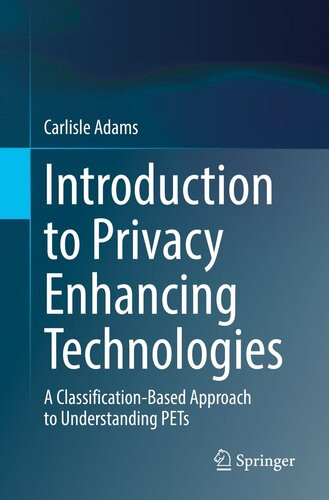Introduction to Privacy Enhancing Technologies A Classification Based Approach to Understanding PETs 1st Edition by Carlisle Adams 3030810429 978-3030810429
$50.00 Original price was: $50.00.$25.00Current price is: $25.00.
Introduction to Privacy Enhancing Technologies A Classification Based Approach to Understanding PETs 1st Edition by Carlisle Adams – Ebook PDF Instant Download/Delivery: 3030810429, 978-3030810429
Full download Introduction to Privacy Enhancing Technologies A Classification Based Approach to Understanding PETs 1st Edition after payment
Product details:
ISBN 10: 3030810429
ISBN 13: 978-3030810429
Author: Carlisle Adams
Why is privacy important? How and why is your privacy being eroded and what risks can this pose for you? What are some tools for protecting your privacy in online environments? How can these tools be understood, compared, and evaluated? What steps can you take to gain more control over your personal data?
This book addresses the above questions by focusing on three fundamental elements:
- It introduces a simple classification of PETs that allows their similarities and differences to be highlighted and analyzed;
- It describes several specific PETs in each class, including both foundational technologies and important recent additions to the field;
- It explainshow to use this classification to determine which privacy goals are actually achievable in a given real-world environment. Once the goals are known, this allows the most appropriate PETs to be selected in order to add the desired privacy protection to the target environment. To illustrate, the book examines the use of PETs in conjunction with various security technologies, with the legal infrastructure, and with communication and computing technologies such as Software Defined Networking (SDN) and Machine Learning (ML).
Designed as an introductory textbook on PETs, this book is essential reading for graduate-level students in computer science and related fields, prospective PETs researchers, privacy advocates, and anyone interested in technologies to protect privacy in online environments.
Introduction to Privacy Enhancing Technologies A Classification Based Approach to Understanding PETs 1st Table of contents:
Chapter 1. The Privacy Minefield
This chapter discusses why privacy enhancing technologies (PETs) exist and why they are important. It provides a definition of privacy that will be assumed throughout this book and describes a number of threats to privacy in our online world. Finally, it suggests that we are in a battle for supremacy over our personal data and argues that unless we increase our awareness and employ suitable tools, there can be serious consequences for our personal lives.
Carlisle Adams
Chapter 2. A Collection of Tools: The Privacy Tree
This chapter highlights the fact that many different PETs have been proposed and used over the past four decades. It suggests that a classification may be a helpful way to compare and contrast these PETs, leading to a greater understanding of which ones are most appropriate for particular privacy goals. A literature review is provided and one selected classification is described in some detail.
Carlisle Adams
Chapter 3. Limiting Exposure by Hiding the Identity
This chapter examines PETs that limit exposure by hiding the user’s identity information. As examples of this category, the following PETs are described: mix networks; anonymous remailers; and onion routing networks. For each of these examples, the original scheme is given, enhancements made over the years are presented, and strengths and limitations of the technology are discussed.
Carlisle Adams
Chapter 4. Limiting Exposure by Hiding the Action
This chapter considers the second leaf in the privacy tree, examining PETs that limit exposure by hiding the user’s actions. As examples of this category, the following PETs are described: transport layer security; network layer security (IPsec in transport mode); and private information retrieval. As with the previous chapter, for each of these examples, the original scheme is given, enhancements made over the years are presented, and strengths and limitations of the technology are discussed.
Carlisle Adams
Chapter 5. Limiting Exposure by Hiding the Identity-Action Pair
This chapter looks at the final category for limiting exposure: PETs that hide both the identity and the actions of the user. The example technologies in this leaf are network layer security (IPsec in tunnel mode) and off-the-record messaging. The chapter discusses the original scheme, some enhancements made over the years, and strengths and limitations of each technology.
Carlisle Adams
Chapter 6. Limiting Disclosure by Hiding the Identity
This chapter begins the examination of techniques that are designed to limit disclosure (rather than exposure). In particular, it focuses on technologies that limit disclosure by hiding the identity of the user. The chapter describes the following example PETs in this category: k-anonymity and credential systems. The basic scheme, enhancements, strengths, and limitations are presented for each of these PETs.
Carlisle Adams
Chapter 7. Limiting Disclosure by Hiding the Attribute
Continuing with the goal of limiting disclosure, this chapter examines technologies that hide the attribute information of the user. The following example PETs in this category are described: ciphertext-policy attribute-based encryption; multi-party computation; and ε-differential privacy. For each presented PET, the basic scheme, enhancements, strengths, and limitations are described.
Carlisle Adams
Chapter 8. Limiting Disclosure by Hiding the Identity-Attribute Pair
This chapter looks at the last leaf in the privacy tree: limiting disclosure by hiding both the identity and the attribute information. Example PETs described in this category are Hippocratic databases, P3P, APEX, and credential systems that prove properties of attributes. As with the previous five chapters, the basic scheme, enhancements, strengths, and limitations are discussed for each PET.
Carlisle Adams
Chapter 9. Using the Privacy Tree in Practice
This chapter discusses how the privacy tree can be used to add privacy protection to real-world environments. This includes using PETs in combination with security technologies, using PETs in conjunction with the legal infrastructure, and using PETs to add privacy to other types of technologies (the specific examples given are software defined networking and machine learning).
Chapter 10. The Path Forward
This chapter briefly summarizes the previous nine chapters and then contemplates what an appropriate response might be to the information that has been presented. Specifically, it suggests that the first step is to make some decisions (How much privacy do you want? What are you willing to “pay” or to give up in order to attain that level of privacy?). The second step is to take some concrete actions to protect your privacy, and four classes of actions that can be taken by anyone are outlined.
People also search for Introduction to Privacy Enhancing Technologies A Classification Based Approach to Understanding PETs 1st:
Tags:
Carlisle Adams,Privacy Enhancing Technologies,Classification Based Approach
You may also like…
Computers - Networking
Computers - Hardware
Poetry - American Poetry
Ecospatiality A Place Based Approach to American Literature 1st Edition Lowell Wyse (Author)
Technique - Nanotechnology
Introduction to Quantum Nanotechnology A Problem Focused Approach 1st Edition Duncan Steel
Computers - Security
Education Studies & Teaching - Pre-school & Early Learning
Relationships & Lifestyle - Alternative Medicine & Natural Healing
Technique - Others
Introduction to Geospatial Technologies 5th Edition Bradley A. Shellito












